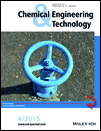Predicting Permeate Fluxes and Rejection Rates in Reverse Osmosis and Tight-Nanofiltration Processes
Abstract
The performance of reverse osmosis and tight nanofiltration with flat-sheet membranes can be predicted accurately. The proposed numerical model solves the local momentum and mass conservation equations in the module's feed channel with solution-diffusion boundary conditions. Both qualitative and quantitative predictions of the permeate flux and of the rejection rate are obtained with an accuracy depending on the limitations of the solution-diffusion model for describing membrane mass transport and on the value of solute permeability. As an extension of the applications to plate-and-frame modules, the ability to describe the performance of processes carried out with spiral-wound modules is also tested with own desalination experiments and with data from the literature.




